Bruno Lage’s tactical approach at SL Benfica is a masterclass in modern football strategy. Known for his ability to blend fluid attacking play with defensive organization, Lage builds teams that dominate possession while remaining compact without the ball. His tenure at Benfica highlights a commitment to high pressing, quick transitions, and versatile build-up play, making his system both effective and exciting to watch. This analysis dives into the core principles behind Lage’s tactics, uncovering the strategies that defined his success and shaped Benfica’s performances on the pitch.
Build-up
Benfica’s attacking structure under Bruno Lage is a showcase of flexibility and adaptability. While they typically begin matches in a classic 1-4-3-3 formation;
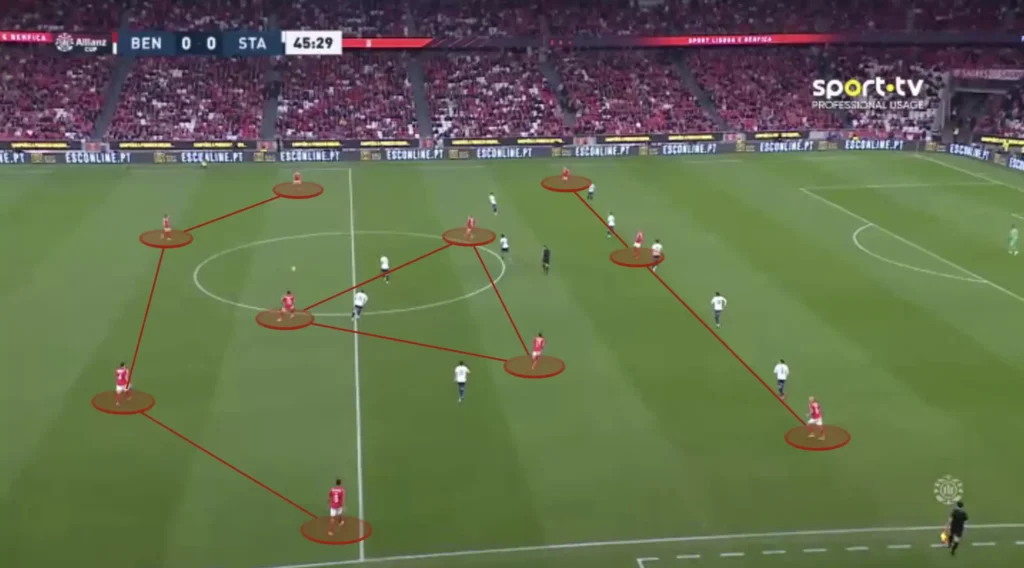
This shape often transforms into others, such as 1-3-4-3;

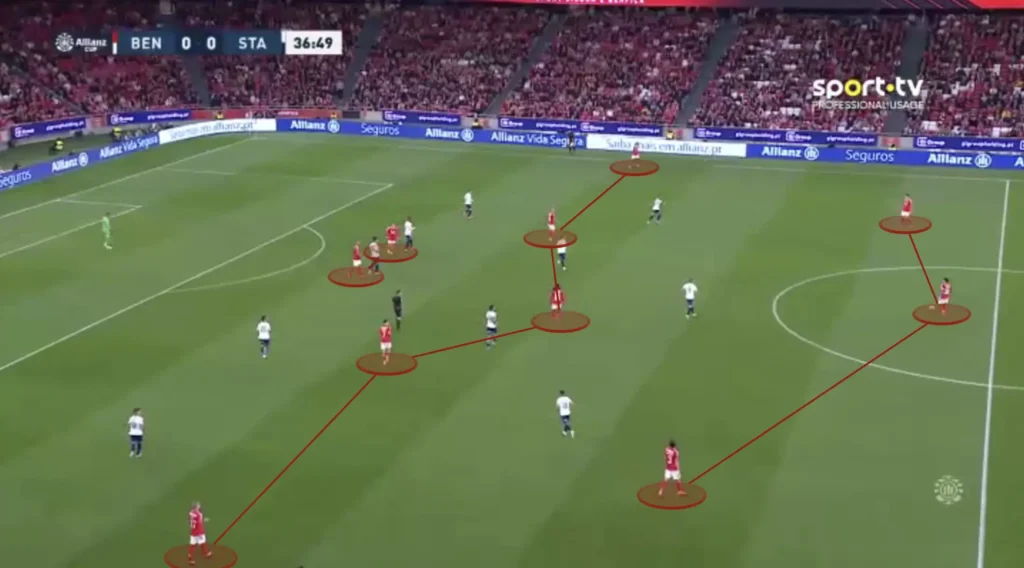
1-3-1-6;
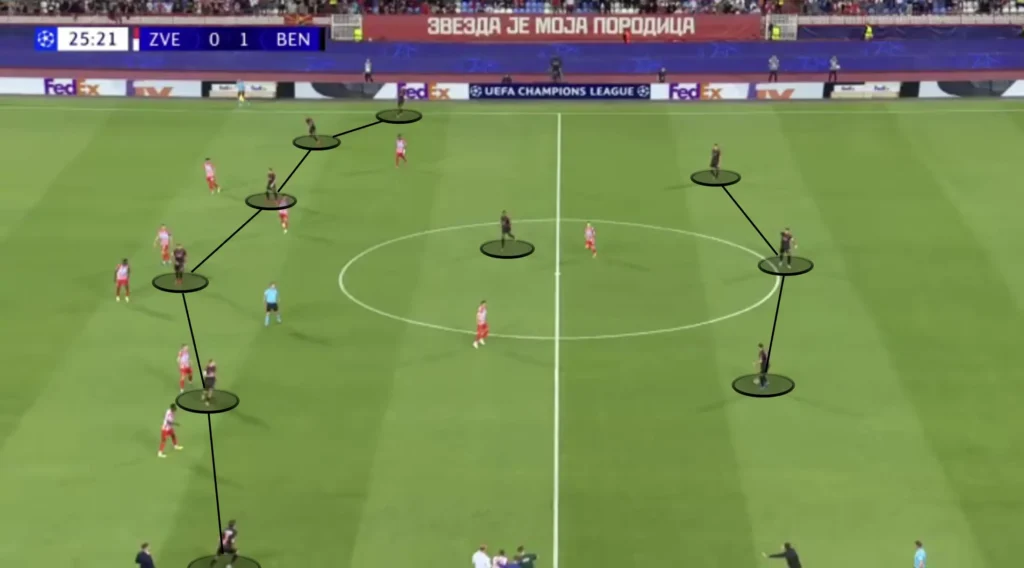
1-2-3-5;
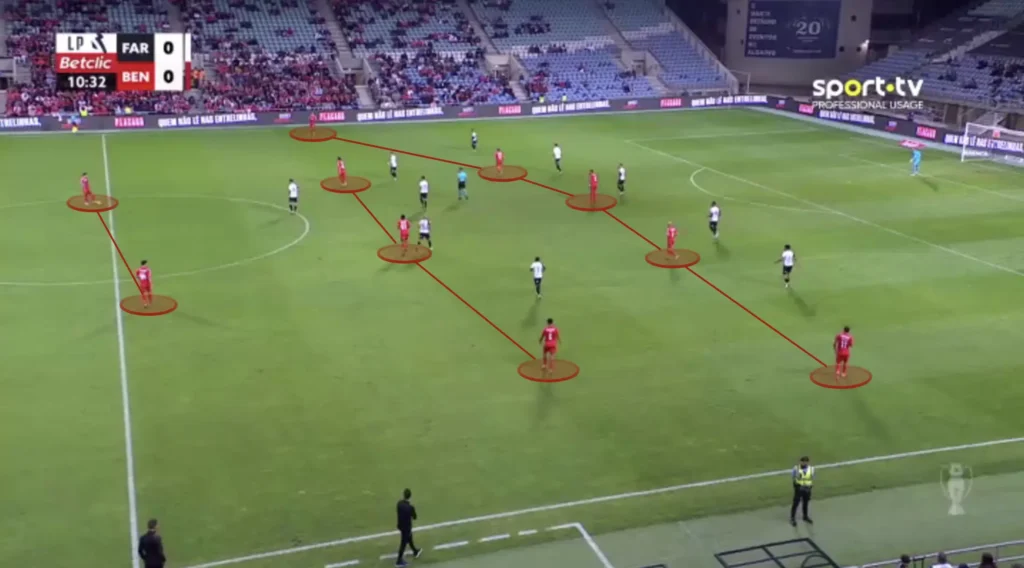
1-2-2-3-1, depending on the game situation.
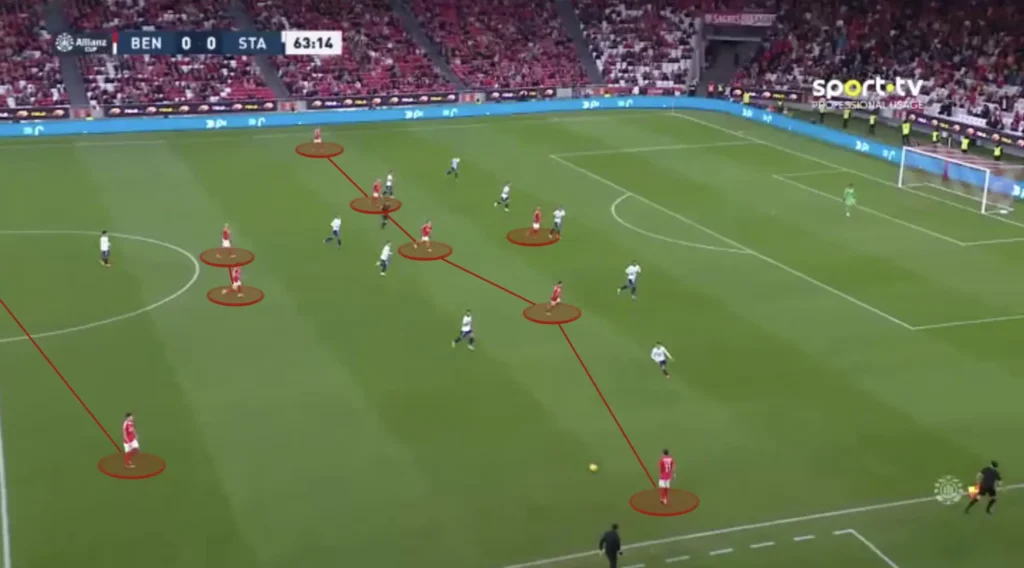
These transitions occur smoothly, both from the start and during the game, as Benfica adjusts to exploit their opponent’s weaknesses or respond to tactical challenges. Bruno Lage’s focus is always to get the players into their best positions, where they can make the most out of their individual skills. He emphasizes versatility, with players interchanging positions seamlessly to maintain possession and disrupt the opposition’s defensive structure.
Bruno Lage’s tactical flexibility allows Benfica to adapt to different defensive setups, create numerical overloads in key areas, and maintain fluidity in possession. By constantly changing their shape, they keep opponents guessing and ensure they remain a dynamic and unpredictable attacking force throughout the match.
Numerical Advantages in the Middle
Regardless of the structure, Benfica will have many players in the center. Bruno Lage usually has a winger/wingback wide on each side and positions the remaining eight players in the middle.
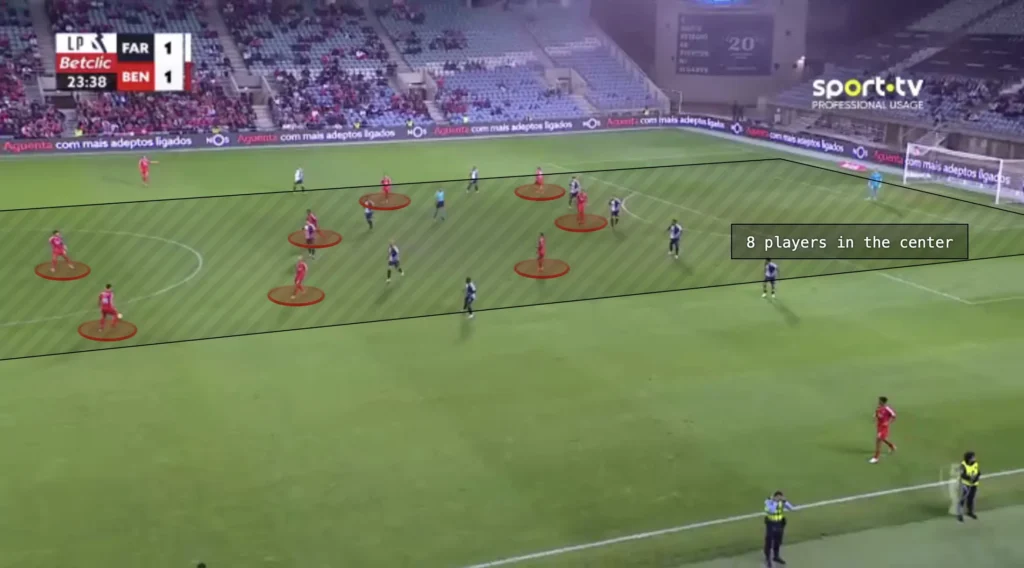
Having only the two wingers/wingbacks out wide and the rest in the middle creates more options in the center and less space between the players. Lage likes this because he prioritizes playing through the middle. He needs one player out wide to pull the opposition apart while the rest create numerical advantages in the midfield areas.
When a team outnumbers the opposition in the midfield, it can more easily retain the ball, exploit spaces, and progress the ball through the center. Benfica will often progress the ball through quick central passes between the midfielders, beating the opposition’s press and exploiting gaps in the defense.
At the same time, having many players centrally builds good conditions in defensive transitions since it allows more players to counterpress when they lose the ball.
Another purpose for keeping many players in the middle is to shorten the distance between them. This shortens the length of the passes, which naturally shortens the time between passes. This means the opposition players will have less time to push up and press, giving the Benfica players more time and control.
Making Runs to Open Space for Teammates
Benfica’s attacking play is, as established, characterized by the constant movement of players, with each individual consistently making runs to open up space for their teammates. The team’s off-the-ball movement is key to their offensive strategy as these runs pull defenders out of position, creating gaps that allow for quick passes and through-balls.
A winger will, for example, often invert during the build-up phase, pulling the opposition fullback into the middle.
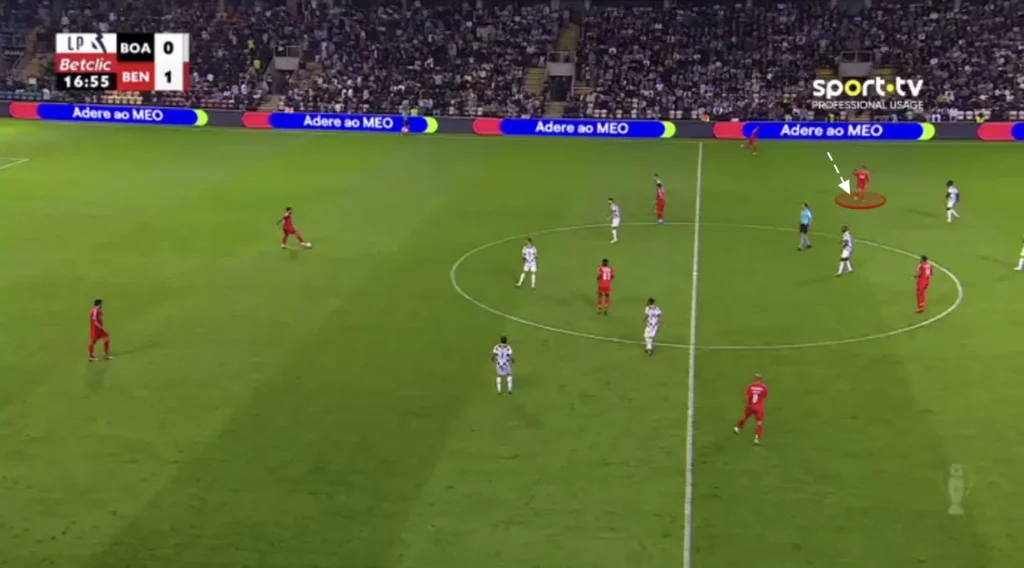
This opens the space out wide for the Benfica fullback to run into and receive a long ball from a center-back.
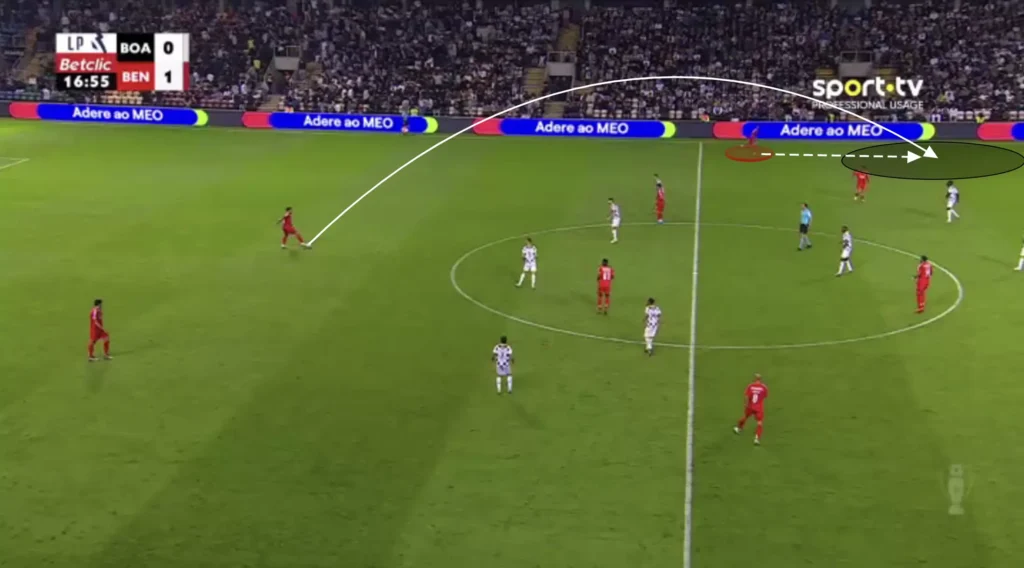
The Benfica midfielders will also make runs to open up space for teammates. When a Benfica defender has the ball, a midfielder might make a run in behind the opposition backline. This drags away an opposition midfielder, opening the space in the midfield for the Benfica striker to drop into. The striker can get a pass from the defender and turn with the ball to progress it forward.
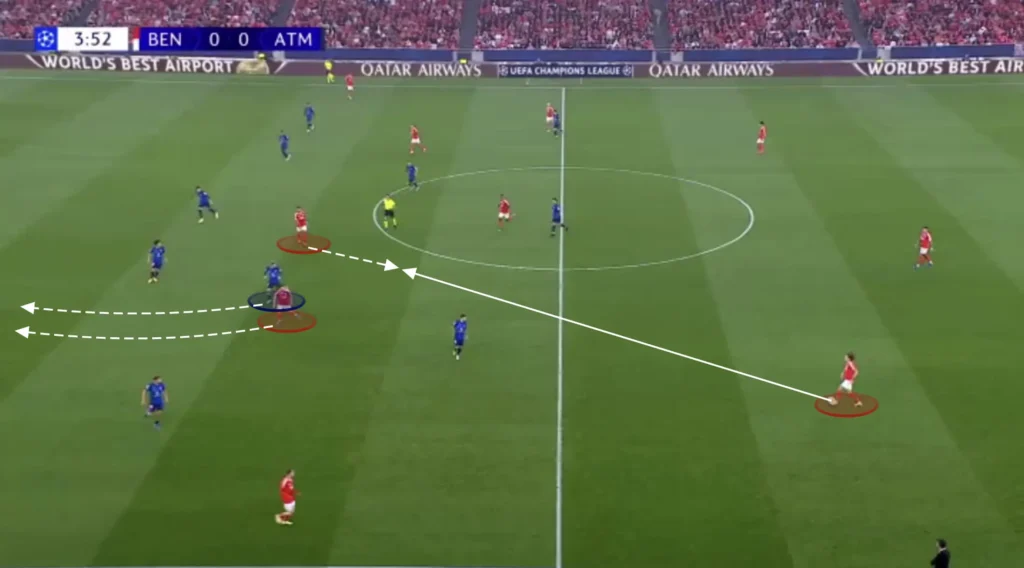
The players will also do simple position changes to open up space for each other. In this situation, for example, a holding midfielder(who is marked) and an attacking midfielder switch positions.
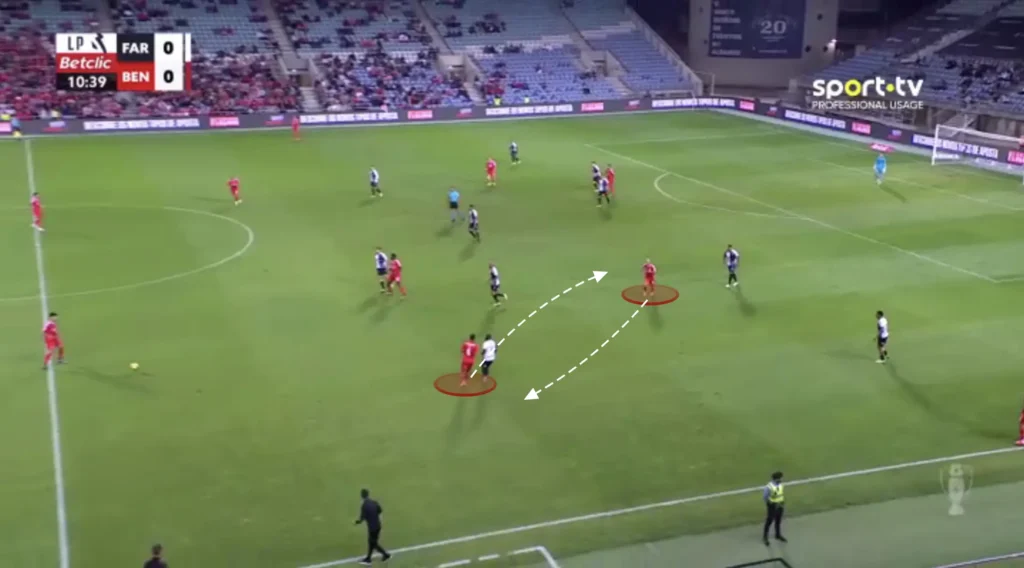
This pulls away the defender and opens the space for the attacking midfielder to receive a pass from the Benfica center-back.
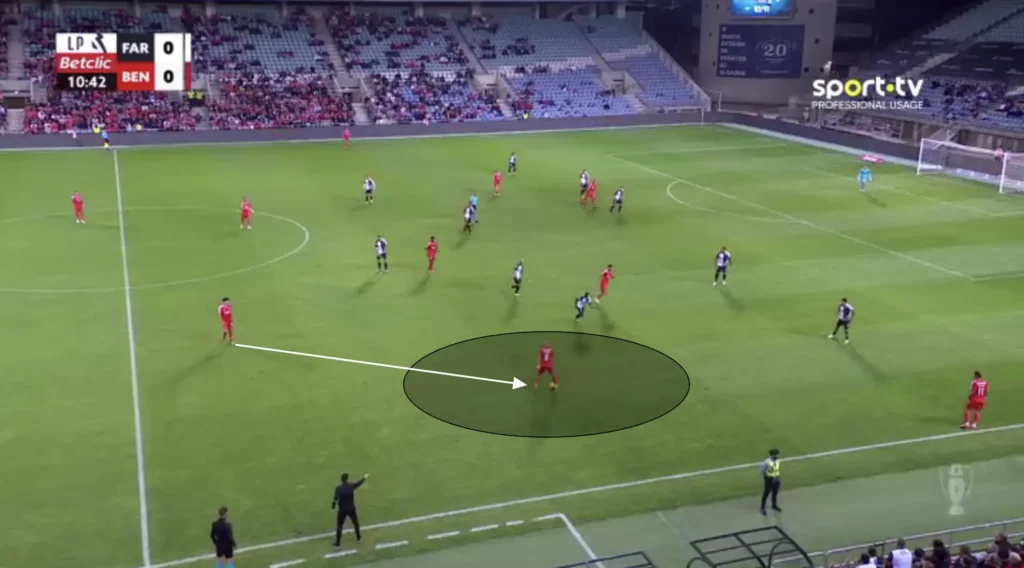
By always looking to make themselves available and running into spaces, Benfica players ensure their attacks remain fluid and unpredictable, making it difficult for the opposition to maintain defensive shape.
Balls in Behind
The Benfica attackers consistently make aggressive runs in behind the opposition defense when a winger or fullback receives the ball out wide. This movement is a key aspect of their offensive strategy, designed to stretch the defensive line and create space. As the wide player advances, the forwards will run in behind the opposition backline, exploiting gaps between defenders and allowing themselves to receive well-placed through-balls. The coordination between the players makes Benfica’s offense unpredictable and difficult to defend against.
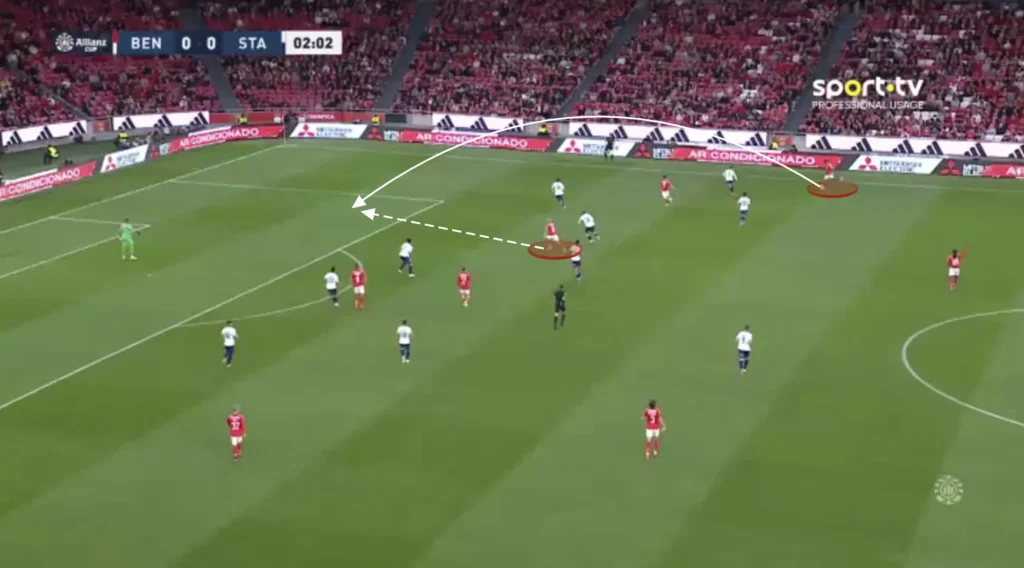
Additionally, this constant threat prevents the opposition from playing with a high backline and closing the space between the lines. Instead, they have to drop the backline and protect the space in behind. This opens the space in front of the backline for the Benfica midfielders to exploit.
In this situation, for example, an attacker makes the run in behind when the winger gets the ball out wide. The opposition backline drops to close the space in behind and stop the winger from playing a through-ball to the running attacker. This opens the space in front of the backline, which another Benfica attacker drops into.
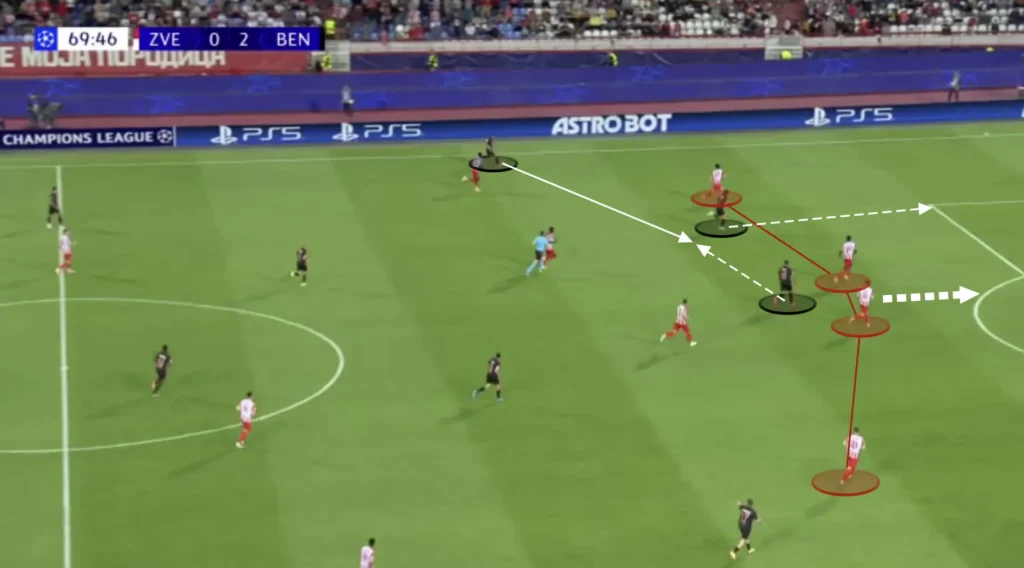
The dropping attacker gets the pass from the winger, turns, and starts attacking the backline.
Counter-Movements
The Benfica attackers will also use counter-movements to make things even more difficult for the opposition defenders. When one attacker makes the run in behind, another one will often drop. This forces the opposition center-backs to make a decision. If they step up on the dropping attacker, the space behind them opens up, allowing Benfica to play a through-ball to the attacker who is making the run in behind. However, if they stay in the backline to cover the run, the ball can be played to the dropping attacker, who can turn and attack the defense.
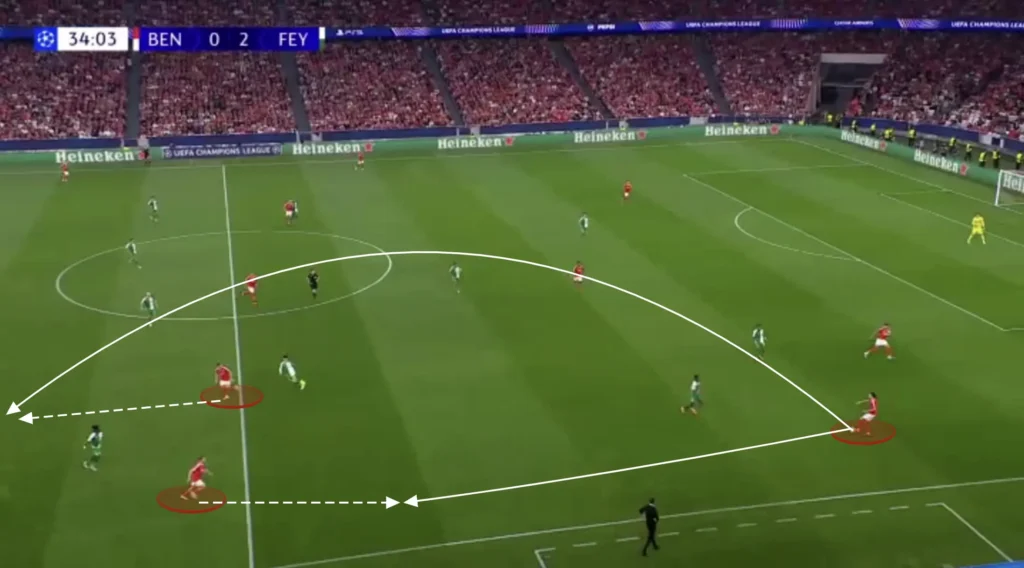
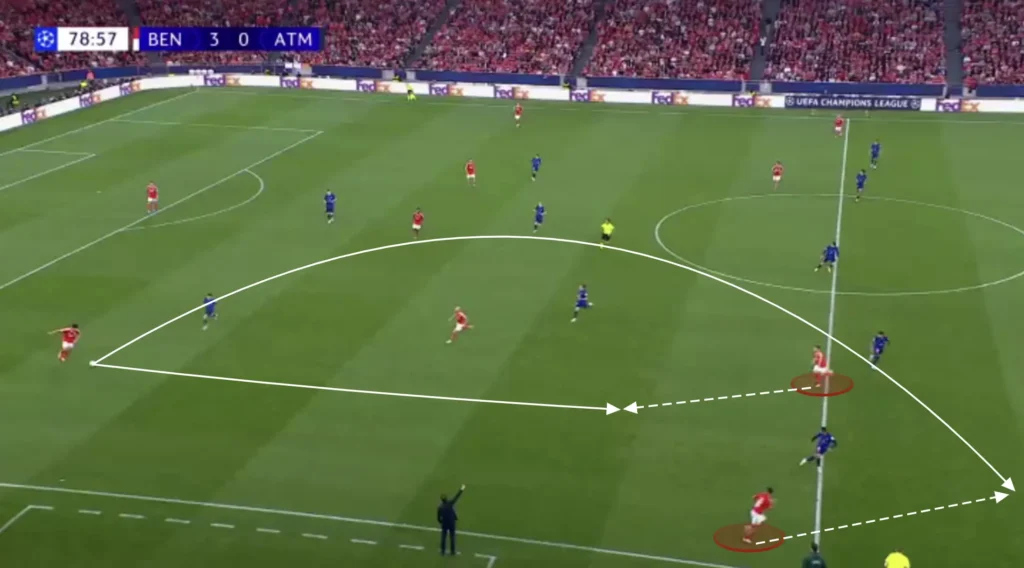
Overlaps
Benfica have used overlaps as a key tactic to create goalscoring opportunities under Bruno Lage. This involves the fullbacks making forward runs to get around their winger, providing an extra attacking option on the flanks. By doing so, they create a 2v1 situation with the winger against the opposition fullback, which could be used to beat the fullback and create crossing opportunities.
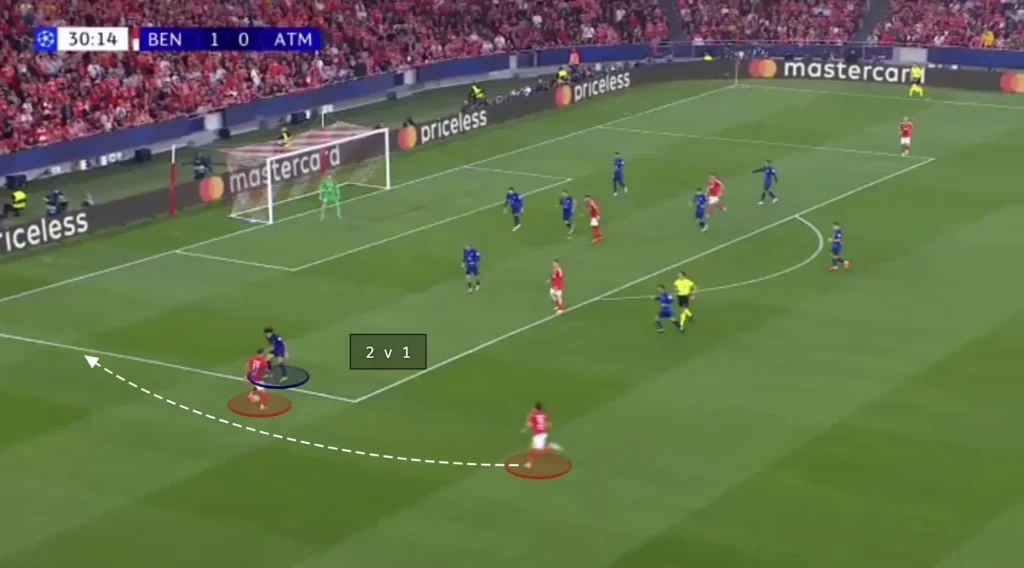
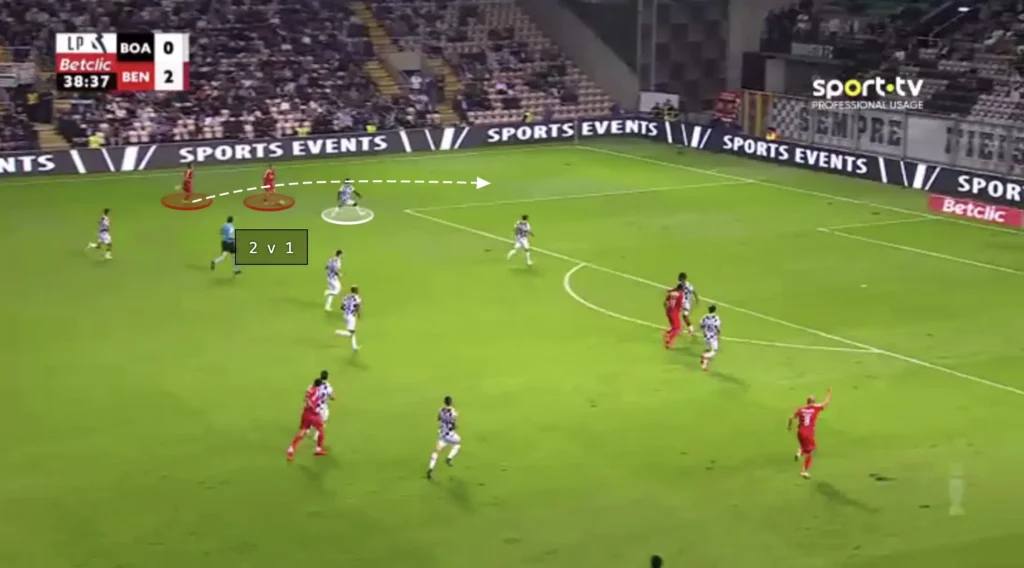
Benfica’s wingers often initiate the play by attracting the opposition fullback, leaving space for an overlapping fullback to exploit. The overlap forces the defending fullback to make difficult decisions—either stick with the winger or follow the overlapping fullback. If the opposition fullback drops to cover the overlapping run, the winger could cut inside and take a shot or combine with a midfielder. If the fullback covers the center, the ball can easily be played to the overlapping player, creating a crossing opportunity.
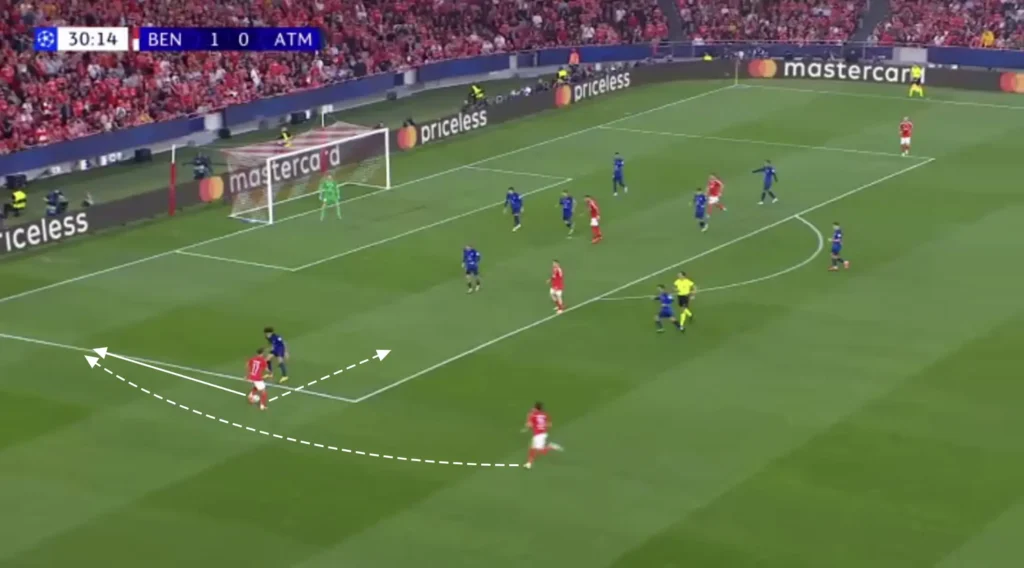
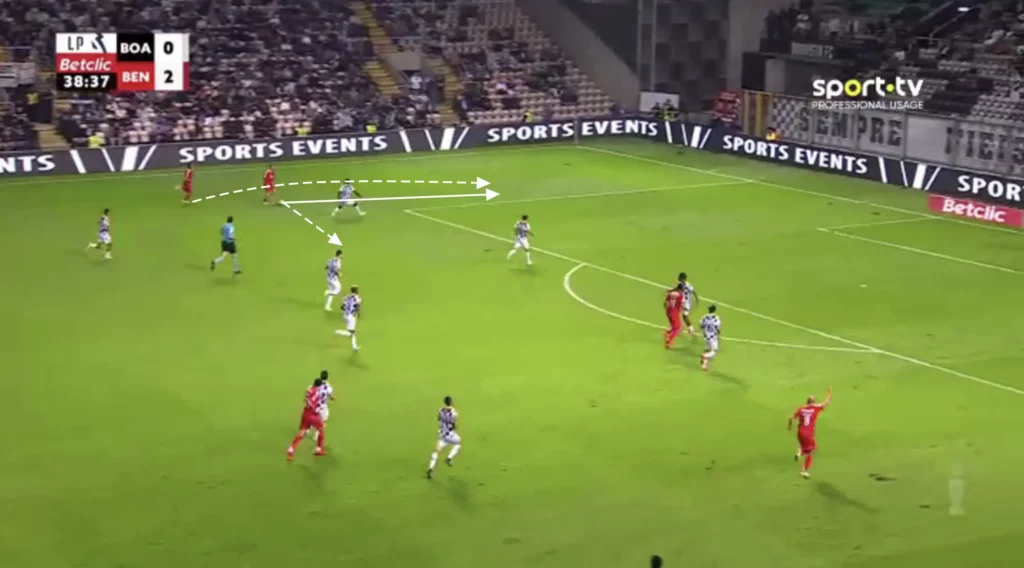
Underlaps
Bruno Lage’s players have also used underlaps to create chances. They primarily do this from the wide areas with underlapping runs from the central midfielders, attacking the space between the opposition center-back and fullback.
When the Benfica winger receives the ball out wide, he will attract the opposition fullback. This opens the space between the opposition fullback and center-back, which allows a Benfica midfielder to make the underlapping run into this space. The ball can be played to the underlapping player, who can cross the ball into the box or attack his defender in a 1v1 situation.
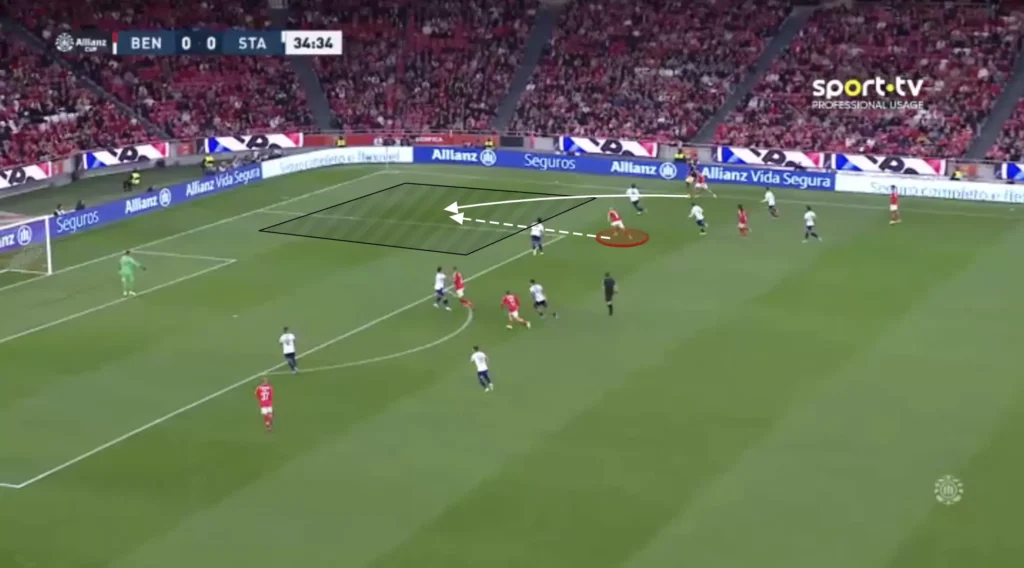
Additionally, the winger does not have to play the ball to the underlapping player. The run from the Benfica midfielder will often drag away an opposition defensive midfielder, which opens the space inside. The winger can take the ball inside and shoot or find a pass to a free player in front of the backline.
Defending
Benfica’s base formation when defending is the 1-4-4-2 formation. They look to set up in a mid-block, always trying to close the center and force the opposition out wide.
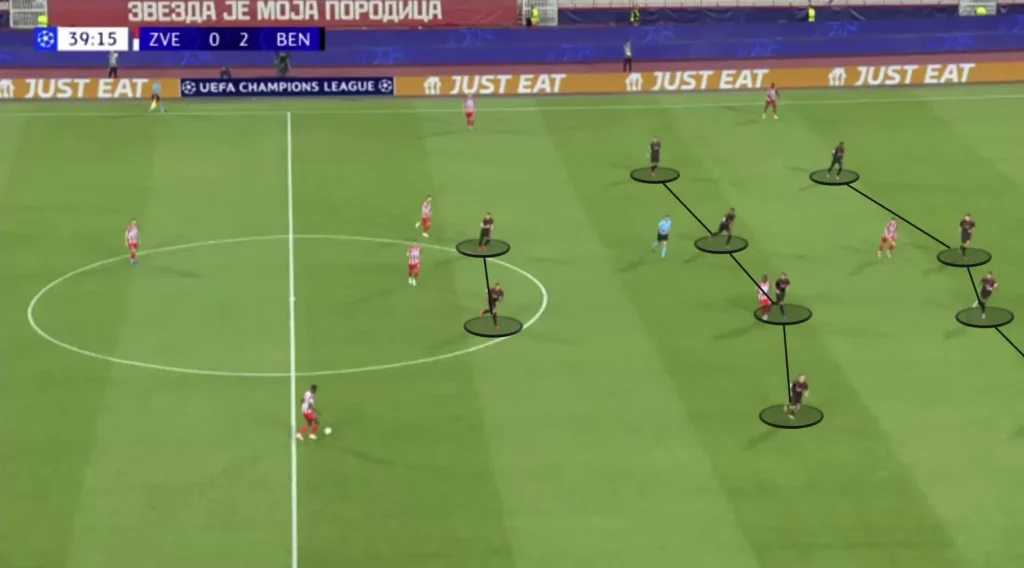
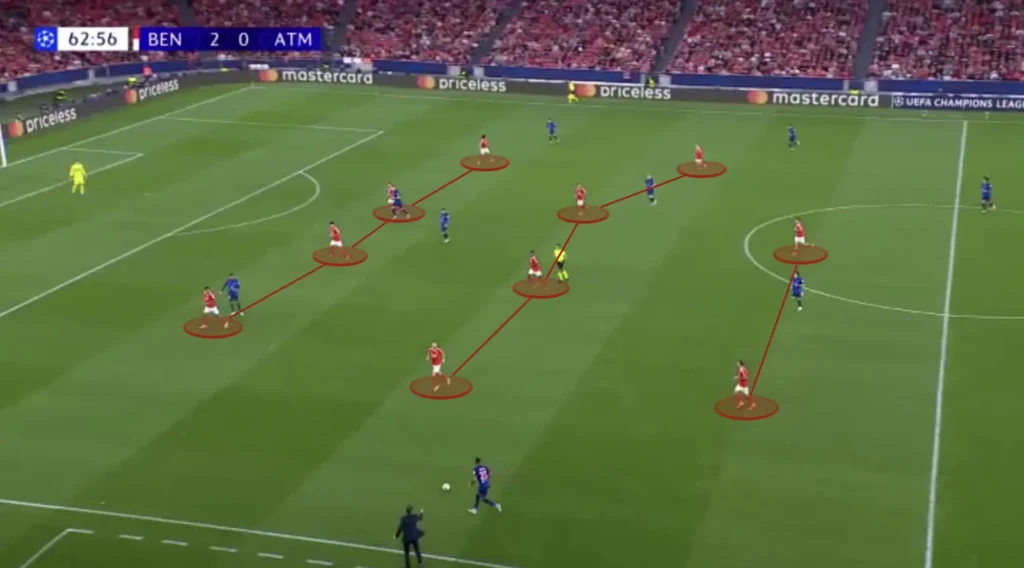
Defending in the 1-4-4-2 formation is all about balance, compactness, and discipline. The team defends in two compact lines of four, with the forwards positioned ahead of the midfield. The two forwards play a crucial role, not only as the first line of defense but also in initiating the team’s pressing strategy. Bruno Lage wants his team to stay compact without dropping too low, preferably closing the space between the midfield and backline.
In some games, mainly when playing against the better teams in the Champions League, Bruno Lage has changed the defensive formation to a 1-5-3-2 structure.
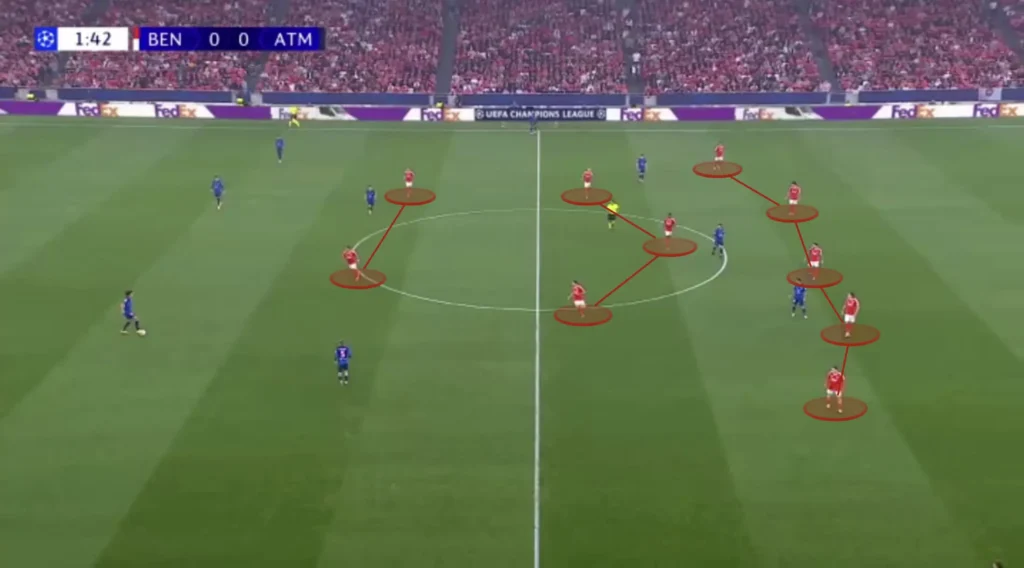
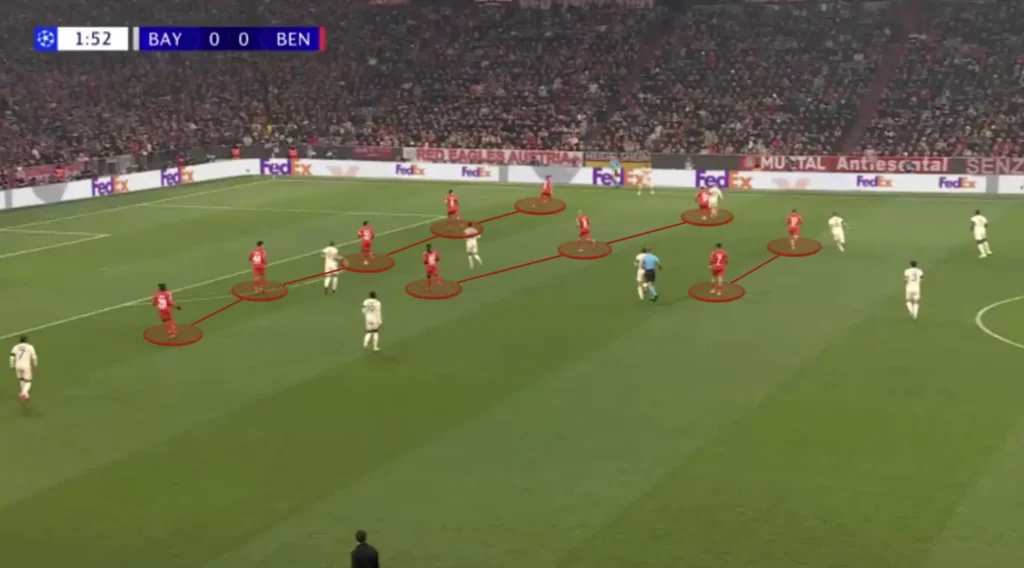
In this formation, they still look to set up in a compact mid-block, but with one extra defender who can deal with dangerous runs from opposition attackers.
The weakness of this defensive structure is that it doesn’t have any wingers who can stop wide advancements. To solve this, the wingback will have to push up when the opposition progress the ball on the flank. When the wingback pushes up, the wide center-back will have to push out into the wingback’s position to provide cover.
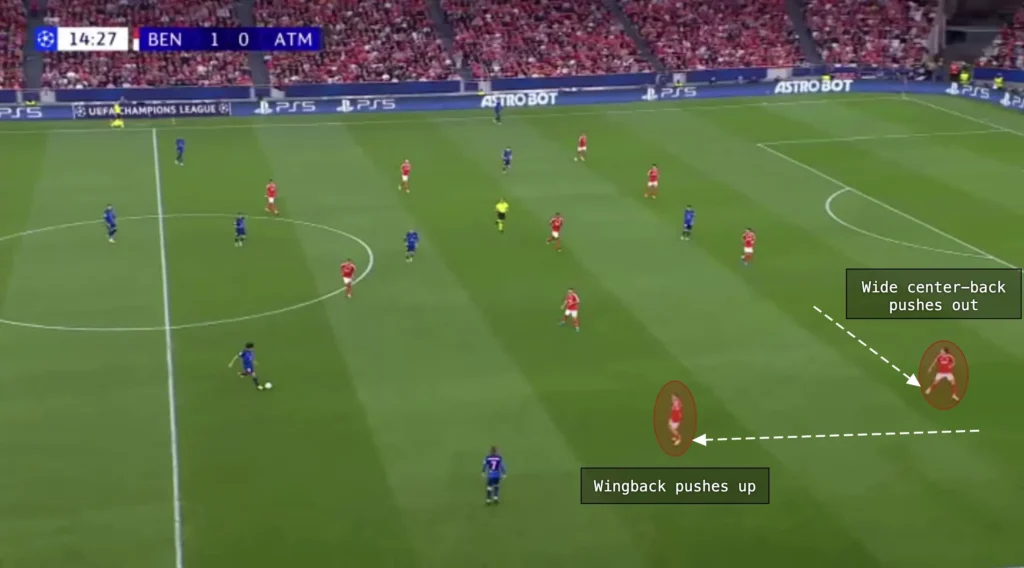
Work Rate
Under Bruno Lage, Benfica exhibit an exceptional work rate that becomes the foundation of their high-intensity style of play. Every player, regardless of position, commits to relentless pressing, quick recovery runs, and constant movement.
The forwards lead the press from the front, while the midfielders tirelessly cover ground to support both defense and attack. When a defender breaks out of shape to put pressure on an opposition player, a Benfica midfielder will always drop into the backline to cover for his teammate.
Benfica’s work rate is present in all parts of the pitch. However, Bruno Lage mainly focuses on all players tracking back to defend their own penalty area.
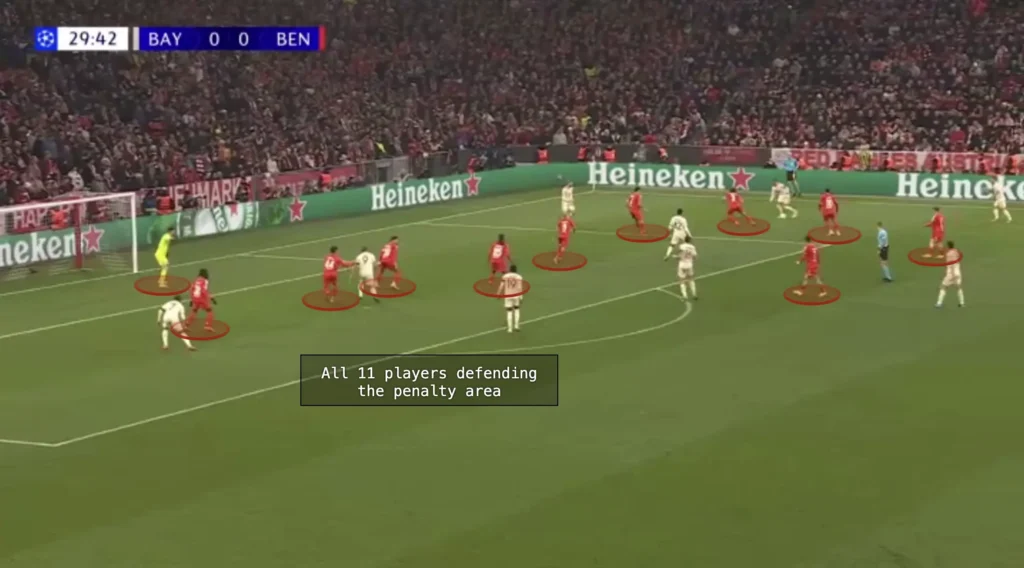
This collective defensive effort ensures the team remains compact, closes down spaces, and creates layers of resistance, making it incredibly difficult for opponents to find clear chances on goal.
Squeezing the Pitch
To prevent his team from becoming too low when defending, Bruno Lage wants his team to squeeze the pitch. This means constantly pushing the team up as much as possible. Every time the opponent plays a slow, sideways pass or a back pass, Benfica’s first line of pressure pushes up, with the rest of the team following to stay compact. When the next pass comes, they push up even more, forcing the opponent back even more.
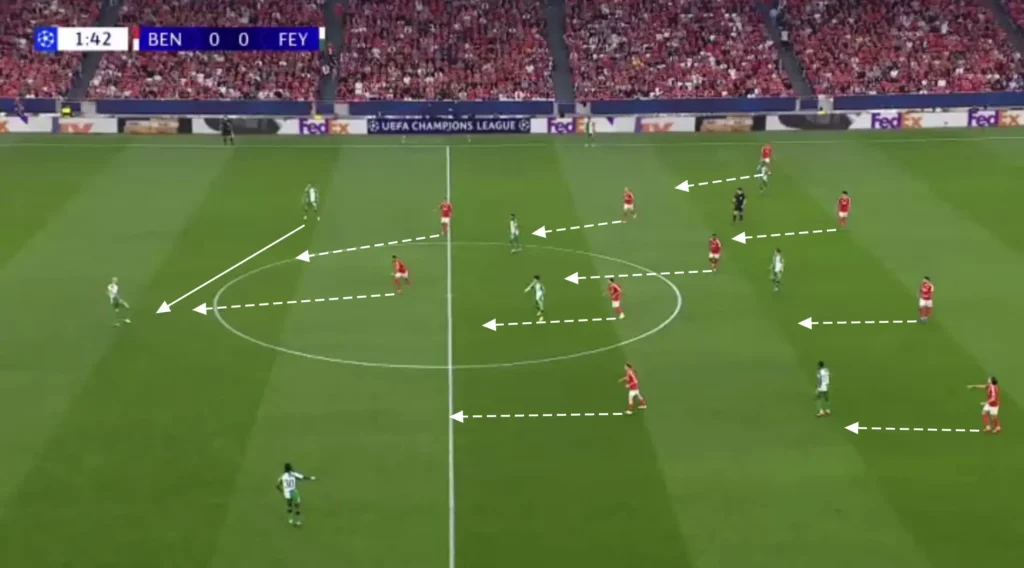
This approach keeps opponents under constant pressure, making it difficult for them to build rhythm or find space between the lines. It also pushes the opponent further away from the Benfica goal, making it harder to create chances.
High Press
Bruno Lage often implements a high-pressing system designed to disrupt the opposition’s build-up and force turnovers in dangerous areas. Their pressing structure will depend on the opposition, but they usually want to be +1 in the backline against the opposition’s forward line to have more control of long balls. This means the pressing players will be numerically inferior against the opposition’s building players.
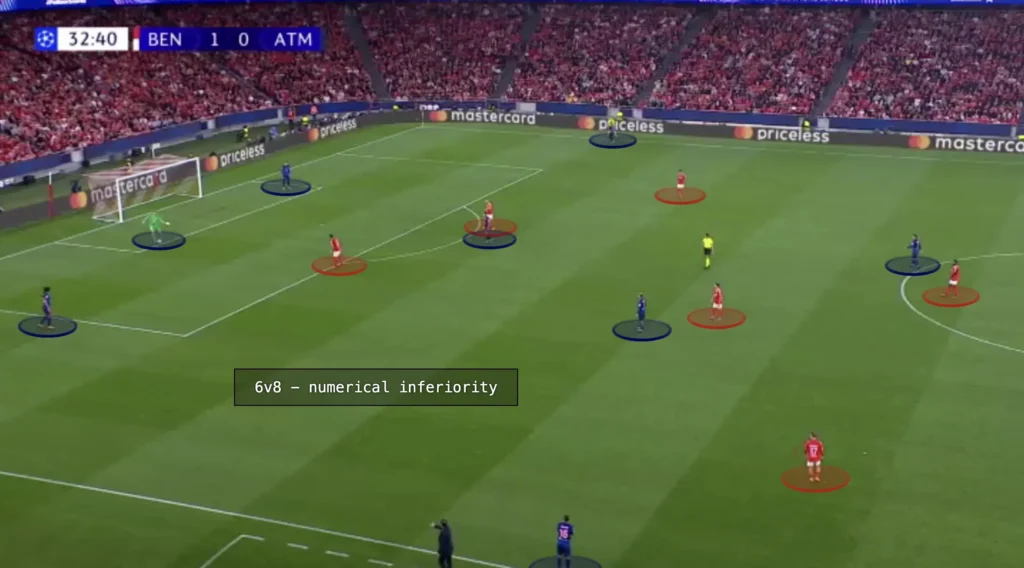
To compensate for this, Benfica will push the opposition to one side and leave the opposition players on the far-side open. This allows them to press the opposition hard despite the numerical inferiority.
When the play starts, the strikers will try to close off one opposition center-back by making angled pressing runs, forcing the opposition to one side. When the opposition plays the ball wide, Benfica’s press shifts into action. The ball-side winger and striker apply immediate pressure to the ball carrier, supported by the nearest central midfielder and fullback. This coordinated effort creates numerical superiority in wide areas, cutting off passing lanes and forcing rushed decisions. The far-side players push over to the ball-side to stay compact and be ready to anticipate switches of play or regain structure if the press is broken.
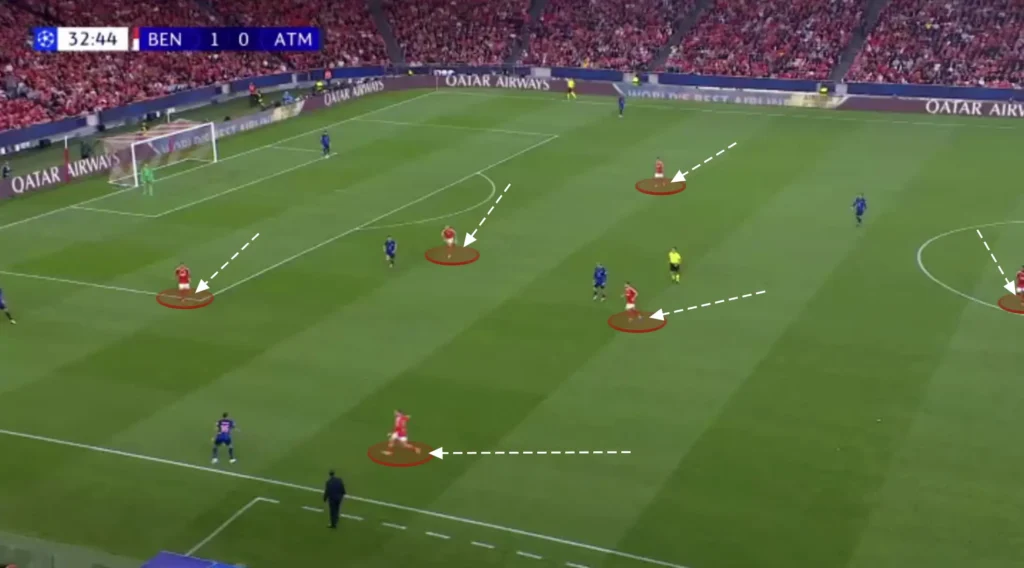
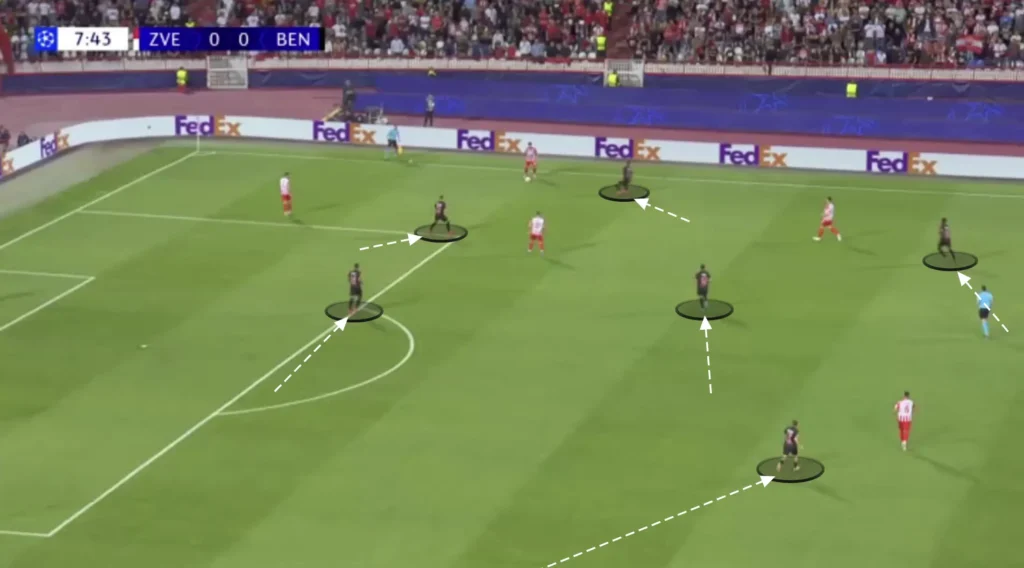
The Benfica winger will press from the inside, closing any passes into the middle. The ball-side striker will try to stop the opposition from switching sides by closing the pass to the ball-side center-back, while the Benfica midfielders, who have shifted across, will push up on the opposition midfielders. This gives the opposition fullback very few passing options and often triggers a rushed long ball, which the Benfica backline usually will win.
This aggressive pressing system targets the flanks, where teams are often more vulnerable under pressure. This maximizes Benfica’s chances of regaining possession and quickly transitioning into attack.
Transitions
Defensive Transitions
Benfica are great in defensive transitions. In possession, they always have many players high up and close to the ball, which creates good conditions for counterpressing. Many players close to the ball after losing possession means that many players can work towards regaining possession. Bruno Lage’s players are also very aggressive in the first seconds after losing the ball. The four or five players closest will immediately jump on the opposition player with the ball and close the distance to cut off any passing lanes. This approach disrupts the opponent’s transition from defense to attack, forcing errors and creating opportunities to regain control in dangerous areas.
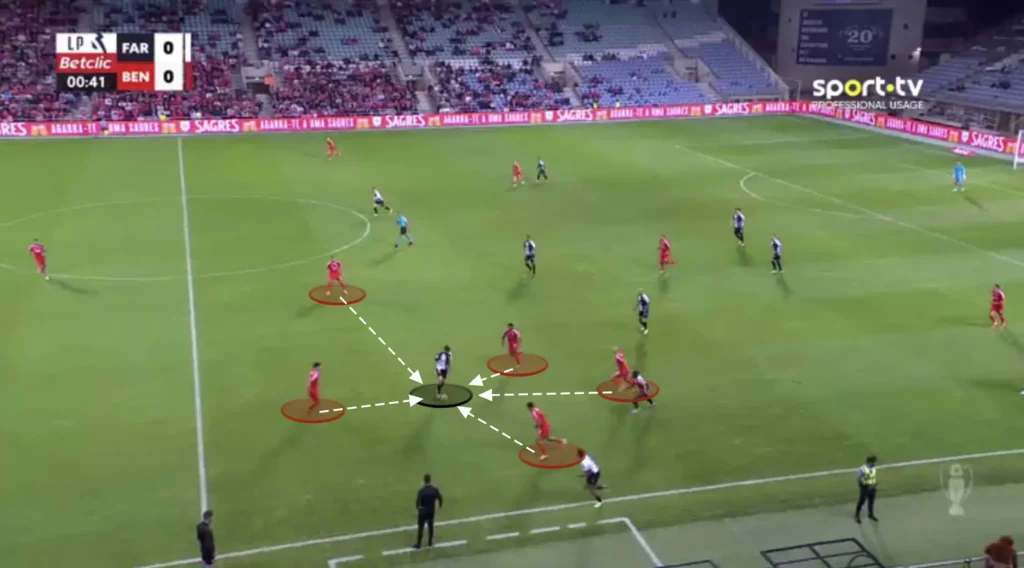
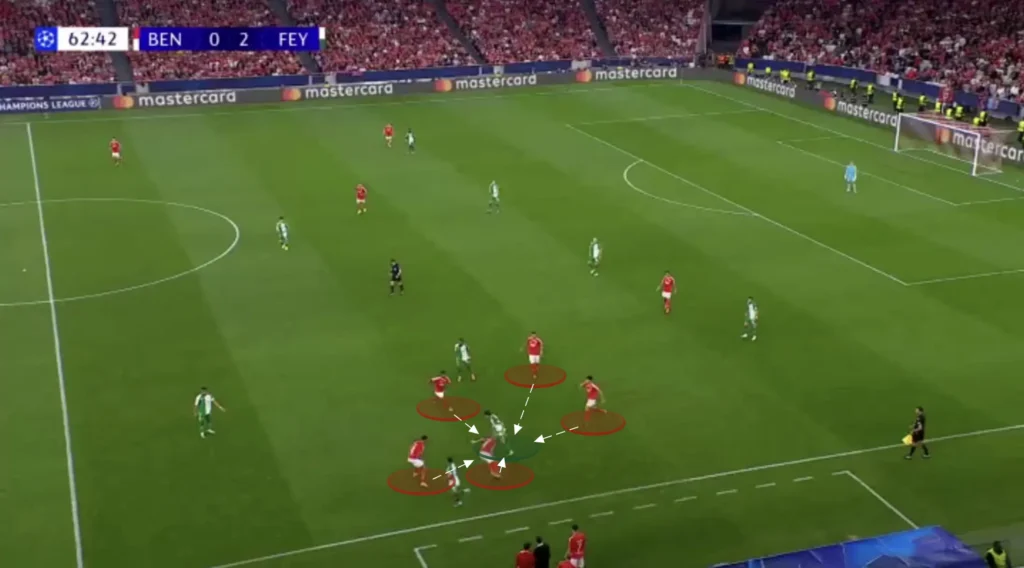
Counterpressing like this keeps Benfica on the front foot, allowing them to dominate possession and create more scoring opportunities. However, it requires exceptional fitness, tactical discipline, and teamwork.
Offensive Transitions
Bruno Lage also wants his team to counterattack in their offensive transitions. When they win back possession, Benfica’s players immediately shift into attack mode, looking to exploit any space left by opponents. Their midfielders, especially the pivots, play a crucial role in initiating quick, vertical passes to the forwards or wide players, who are already positioned to make penetrating runs. This rapid transition is often supported by overlapping fullbacks, providing width and stretching the opposition’s defense. With these quick movements, the Benfica players frequently catch teams off guard, creating high-quality chances before the opponent can regroup defensively. Bruno Lages’s system makes Benfica’s counterattacks highly effective, balancing directness with calculated positioning to break through defenses with minimal delay.
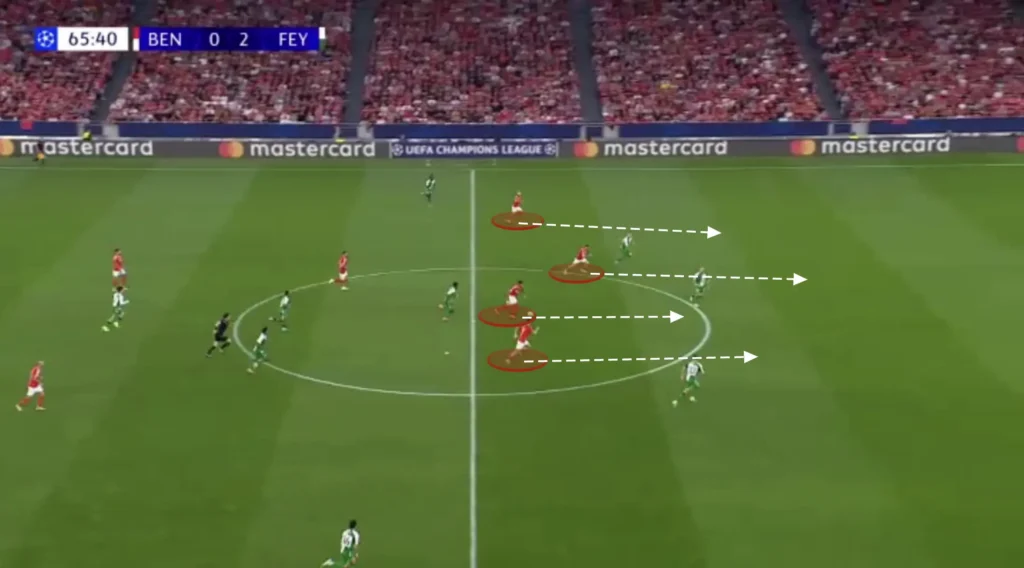
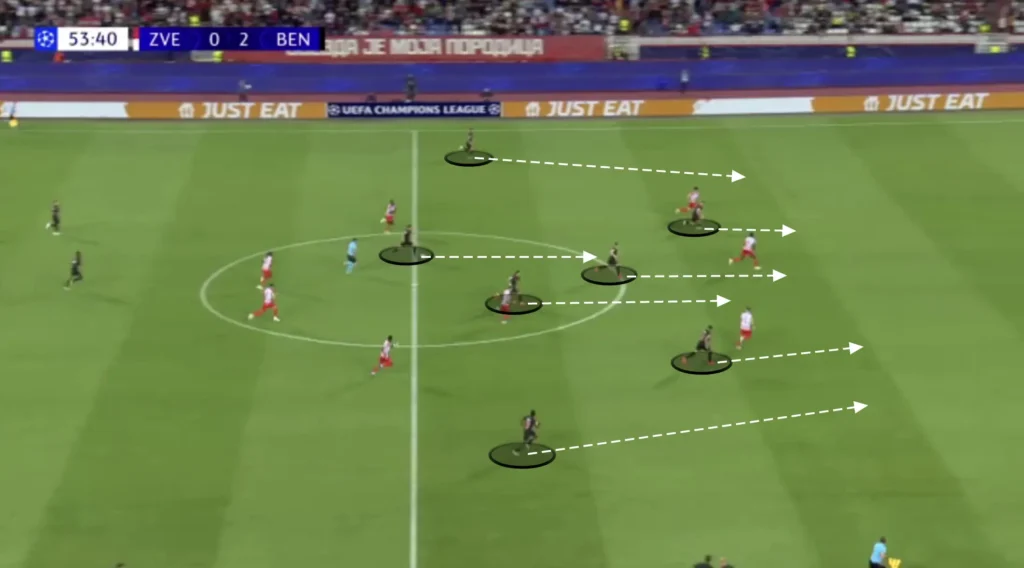
Additionally, the Benfica players are great at finding open spaces in the counterattacks. Instead of playing the ball straight forward where opposition defenders may still be positioned, they play a sideways or diagonal pass, allowing the team to bypass pressure and shift the play into open areas. From these areas, the Benfica attackers can take the ball forward and quickly get past the opposition to create a goalscoring opportunity.
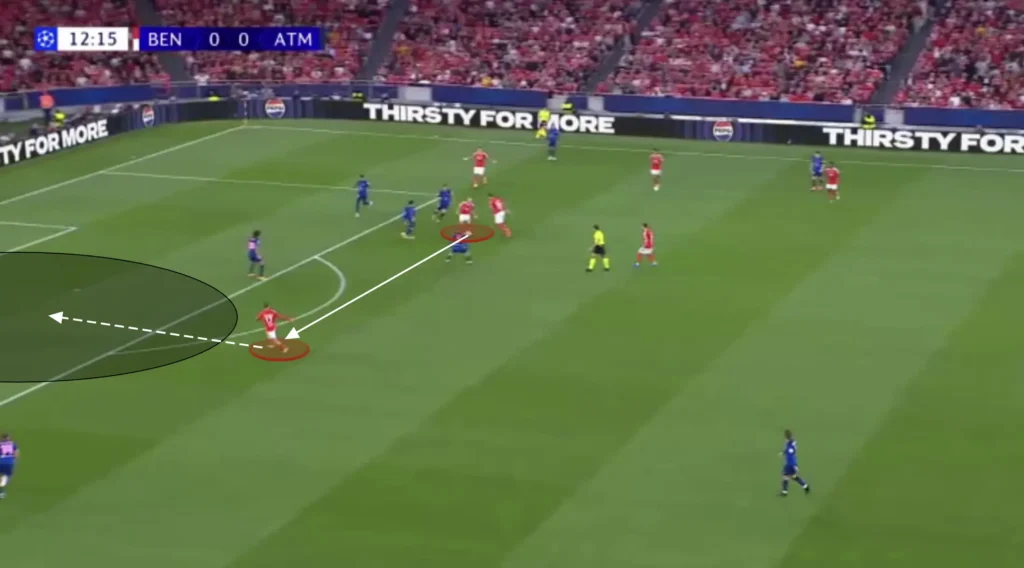
Benfica also try to involve many players in their counterattacks, creating varied options and making it difficult for opponents to predict the next move. This ensures that Benfica have plenty of support around the ball and several passing options in transition.
Final Thoughts
In conclusion, Bruno Lage’s tactical approach at SL Benfica reflects a blend of strategic precision and attacking intent. His system emphasizes dynamic movement, intelligent positioning, and the ability to adapt to different phases of play. With a focus on creating numerical superiority in key areas and exploiting spaces effectively, his tactics bring a balance of structure and creativity to Benfica’s game.
This analysis highlights how Lage’s philosophy encourages a proactive style of play, ensuring his team maintains control while remaining a constant offensive threat. Whether in build-up, transitions, or defensive organization, Lage’s Benfica showcases a modern, cohesive tactical framework that drives the team’s success on the pitch.
